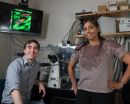(Press-News.org) A new cultural psychology study has found that psychological differences between the people of northern and southern China mirror the differences between community-oriented East Asia and the more individualistic Western world – and the differences seem to have come about because southern China has grown rice for thousands of years, whereas the north has grown wheat.
"It's easy to think of China as a single culture, but we found that China has very distinct northern and southern psychological cultures and that southern China's history of rice farming can explain why people in southern China are more interdependent than people in the wheat-growing north," said Thomas Talhelm, a University of Virginia Ph.D. student in cultural psychology and the study's lead author. He calls it the "rice theory."
The findings appear in the May 9 issue of the journal Science.
Talhelm and his co-authors at universities in China and Michigan propose that the methods of cooperative rice farming – common to southern China for generations – make the culture in that region interdependent, while people in the wheat-growing north are more individualistic, a reflection of the independent form of farming practiced there over hundreds of years.
"The data suggests that legacies of farming are continuing to affect people in the modern world," Talhelm said. "It has resulted in two distinct cultural psychologies that mirror the differences between East Asia and the West."
According to Talhelm, Chinese people have long been aware of cultural differences between the north region and the southern, which are divided by the Yangtze River – the largest river in China, flowing west to east across the vast country. People in the north are thought to be more aggressive and independent, while people to the south are considered more cooperative and interdependent.
"This has sometimes been attributed to different climates – warmer in the south, colder in the north – which certainly affects agriculture, but it appears to be more related to what Chinese people have been growing for thousands of years," Talhelm said.
He notes that rice farming is extremely labor-intensive, requiring about twice the number of hours from planting to harvest as does wheat. And because most rice is grown on irrigated land, requiring the sharing of water and the building of dikes and canals that constantly require maintenance, rice farmers must work together to develop and maintain an infrastructure upon which all depend. This, Talhelm argues, has led to the interdependent culture in the southern region.
Wheat, on the other hand, is grown on dry land, relying on rain for moisture. Farmers are able to depend more on themselves, leading to more of an independent mindset that permeates northern Chinese culture.
Talhelm developed his rice theory after living in China for four years. He first went to the country in 2007 as a high school English teacher in Guangzhou, in the rice-growing south.
A year later, he moved to Beijing, in the north. On his first trip there, he noticed that people were more outgoing and individualistic than in the south.
"I noticed it first when a museum curator told me my Chinese was clearly better than my roommate's," Talhelm said. "The curator was being direct and a little less concerned about how her statement might make us feel."
After three years in China, including time as a journalist, he later went back as a U.Va. doctoral student on a Fulbright scholarship.
"I was pretty sure the differences I was seeing were real, but I had no idea why northern and southern China were so different – where did these differences come from?" Talhelm asked.
He soon found that the Yangtze was an important cultural divider in China. "I found out that the Yangtze River helped divide dialects in China, and I soon learned that the Yangtze also roughly divides rice farming and wheat farming," he said.
He dug into anthropologists' accounts of pre-modern rice and wheat villages and realized that they might account for the different mindsets, carried forward from an agrarian past into modernity.
"The idea is that rice provides economic incentives to cooperate, and over many generations, those cultures become more interdependent, whereas societies that do not have to depend on each other as much have the freedom of individualism," Talhelm said.
He went about investigating this with his Chinese colleagues by conducting psychological studies of the thought styles of 1,162 Han Chinese college students in the north and south and in counties at the borders of the rice-wheat divide.
They found through a series of tests that northern Chinese were indeed more individualistic and analytic-thinking – more similar to Westerners – while southerners were interdependent, holistic-thinking and fiercely loyal to friends, as psychological testing has shown is common in other rice-growing East Asian nations, such as Japan and Korea.
The study was conducted in six Chinese cities: Beijing in the north; Fujian in the southeast; Guangdong in the south; Yunnan in the southwest; Sichuan in the west central; and Liaoning in the northeast.
Talhelm said that one of the most striking findings was that counties on the north-south border – just across the Yangtze River from each other – exhibited the same north/south psychological characteristics as areas much more distantly separated north and south.
"I think the rice theory provides some insight to why the rice-growing regions of East Asia are less individualistic than the Western world or northern China, even with their wealth and modernization," Talhelm said.
He expects to complete his Ph.D. next year, and this year received an Arts, Humanities and Social Sciences Research Fellowship from U.Va.'s Office of the Vice President for Research and the Graduate School of Arts & Sciences for an in-depth study of people from the rice-wheat border in China's Anhui province.
INFORMATION: END
'Rice theory' explains north-south China cultural differences, study shows
2014-05-08
ELSE PRESS RELEASES FROM THIS DATE:
Exploring the magnetism of a single atom
2014-05-08
Magnetic devices like hard drives, magnetic random access memories (MRAMs), molecular magnets, and quantum computers depend on the manipulation of magnetic properties. In an atom, magnetism arises from the spin and orbital momentum of its electrons. 'Magnetic anisotropy' describes how an atom's magnetic properties depend on the orientation of the electrons' orbits relative to the structure of a material. It also provides directionality and stability to magnetization. Publishing in Science, researchers led by EPFL combine various experimental and computational methods to ...
Plant hormone has dual role in triggering flower formation, Penn study finds
2014-05-08
Flowers aren't just pretty to look at, they are how plants reproduce. In agricultural plants, the timing and regulation of flower formation has economic significance, affecting a crop's yield.
A new paper by researchers at the University of Pennsylvania published in the journal Science has revealed that a plant hormone once believed to promote flower formation in annual plants also plays a role in inhibiting flowers from forming. The dual role of this hormone, gibberellin, could be exploited to produce higher-yielding crop plants.
The study was led by Nobutoshi Yamaguchi ...
GaitTrack app makes cellphone a medical monitor for heart and lung patients
2014-05-08
CHAMPAIGN, Ill. — By simply carrying around their cellphones, patients who suffer from chronic disease could soon have an accurate health monitor that warns their doctors when their symptoms worsen.
GaitTrack, an app developed by researchers at the University of Illinois at Urbana-Champaign and the U. of I. at Chicago, turns a smartphone into a sophisticated medical device. Unlike other apps that merely count steps, GaitTrack uses eight motion parameters to perform a detailed analysis of a person's gait, or walking pattern, which can tell physicians much about a patient's ...
Tackling test anxiety may help prevent more severe problems
2014-05-08
Showing students how to cope with test anxiety might also help them to handle their built-up angst and fretfulness about other issues. The results of a new study by Carl Weems of the University of New Orleans show that anxiety intervention programs that focus on academic matters fit well into the demands of the school routine, and do not carry the same stigma among youth as general anxiety programs do. The research group was among the first to study the effects of Hurricane Katrina on community mental health and anxiety among youths, and the paper appears in Prevention ...
Ovarian cancer cells are more aggressive on soft tissues
2014-05-08
When ovarian cancer spreads from the ovaries it almost always does so to a layer of fatty tissue that lines the gut. A new study has found that ovarian cancer cells are more aggressive on these soft tissues due to the mechanical properties of this environment. The finding is contrary to what is seen with other malignant cancer cells that seem to prefer stiffer tissues.
"What we found is that there are some cancer cells that respond to softness as opposed to stiffness," said Michelle Dawson, an assistant professor in the School of Chemical and Biomolecular Engineering ...
Army drug users twice as likely to use synthetic marijuana as regular marijuana
2014-05-08
Social work researchers from the University of Washington have found that among a group of active-duty Army personnel who use illicit drugs, the most abused substance is synthetic marijuana, which is harder to detect than other drugs through standard drug tests.
The research will be published in the July 2014 issue of Addictive Behaviors, but is already online.
Synthetic marijuana, sometimes called "Spice," is made with shredded plant material coated with chemicals that are designed to mimic THC, the psychoactive compound found naturally in marijuana. The U.S. Drug ...
Single cell genome sequencing of malaria parasites
2014-05-08
SAN ANTONIO, May 8, 2014 – A new method for isolating and genome sequencing an individual malaria parasite cell has been developed by Texas Biomed researchers and their colleagues. This advance will allow scientists to improve their ability to identify the multiple types of malaria parasites infecting patients and lead to ways to best design drugs and vaccines to tackle this major global killer. Malaria remains the world's deadliest parasitic disease, killing 655,000 people in 2010.
Malaria parasite infections are complex and often contain multiple different parasite genotypes ...
New genomics technique could improve treatment and control of Malaria
2014-05-08
Single-cell genomics could provide new insight into the biology of Malaria parasites, including their virulence and levels of drug resistance, to ultimately improve treatment and control of the disease, according to new research funded by the Wellcome Trust and the National Institutes of Health.
The findings are revealed in a study by researchers at the Texas Biomedical Research Institute and published today in the journal Genome Research.
Malaria infections commonly contain complex mixtures of Plasmodium parasites which cause the disease. These mixtures, known as multiple ...
Open science journal publishes attempt to reproduce high-profile stem cell acid bath study
2014-05-08
In a study published today in F1000Research, Professor Kenneth Lee of the Chinese University of Hong Kong reveals the full experimental results of an attempt to replicate a controversial study published in Nature recently that suggested that bathing somatic cells in acid can reprogram them to induced pluripotent stem cells (iPS cells). With systematically collected and fully available data, Lee and his colleagues report that carefully replicating the original acid-treatment method does not induce pluripotency in two types of mouse somatic cells, including those used in ...
NASA sees system 90E moving toward southwestern Mexico
2014-05-08
A tropical low pressure area known as System 90E is located a couple of hundred miles southwest of Zihuatenejo, Mexico today and was seen by NASA's Terra satellite on its way to a landfall.
The Moderate Resolution Imaging Spectroradiometer (MODIS) instrument aboard NASA's Terra satellite captured a visible image of System 90E on May 7 at 18:50 UTC/ 2:50 p.m. EDT as it headed to a landfall in southwestern Mexico. The low appeared disorganized as it approached the southwestern coast of Mexico near the states of Michoacan and Guerrero.
According to NOAA's National Hurricane ...


